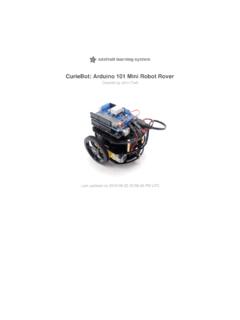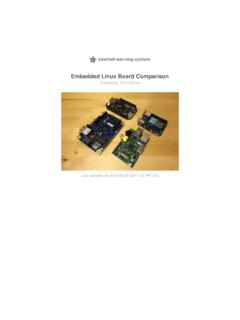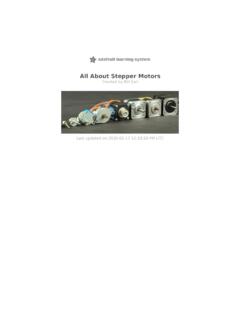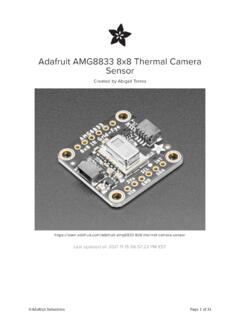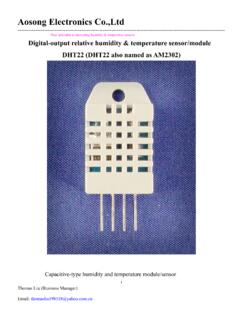Transcription of PIR Motion Sensor - Adafruit Industries
1 PIR Motion SensorCreated by lady ada updated on 2021-11-15 05:48:12 PM EST Adafruit IndustriesPage 1 of 25355681213141617181919202325 Table of ContentsOverview Some Basic StatsHow PIRs Work The PIR Sensor LensesConnecting to a PIRT esting a PIR Retriggering Changing sensitivity Changing Pulse Time and Timeout Length For older/other PIR sensorsUsing a PIR w/Arduino Reading PIR SensorsCircuitPython CodeExample ProjectsBuy a PIR Motion Sensor Adafruit IndustriesPage 2 of 25 Overview PIR sensors allow you to sense Motion , almost always used to detect whether ahuman has moved in or out of the sensors range. They are small, inexpensive, low-power, easy to use and don't wear out. For that reason they are commonly found inappliances and gadgets used in homes or businesses. They are often referred to asPIR, "Passive Infrared", "Pyroelectric", or "IR Motion " sensors. PIRs are basically made of a pyroelectric Sensor ( ) (which you cansee below as the round metal can with a rectangular crystal in the center), which candetect levels of infrared radiation.
2 Everything emits some low level radiation, and thehotter something is, the more radiation is emitted. The Sensor in a Motion detector isactually split in two halves. The reason for that is that we are looking to detect Motion (change) not average IR levels. The two halves are wired up so that they cancel eachother out. If one half sees more or less IR radiation than the other, the output willswing high or low. Adafruit IndustriesPage 3 of 25 Along with the pyroelectic Sensor is a bunch of supporting circuitry, resistors andcapacitors. It seems that most small hobbyist sensors use the BISS0001 ("Micro PowerPIR Motion Detector IC") ( ), undoubtedly a very inexpensive chip takes the output of the Sensor and does some minor processing on it to emita digital output pulse from the analog older PIRs looked like this:Our new PIRs have more adjustable settings and have a header installed in the 3-pinground/out/power padsFor many basic projects or products that need to detect when a person has left orentered the area, or has approached, PIR sensors are great.
3 They are low power and Adafruit IndustriesPage 4 of 25low cost, pretty rugged, have a wide lens range, and are easy to interface with. Notethat PIRs won't tell you how many people are around or how close they are to thesensor, the lens is often fixed to a certain sweep and distance (although it can behacked somewhere) and they are also sometimes set off by is key! Some Basic StatsThese stats are for the PIR Sensor in the Adafruit shop which is very much like theParallax one ( ) . Nearly all PIRs will have slightly differentspecifications, although they all pretty much work the same. If there's a datasheet,you'll want to refer to itSize: RectangularPrice: $ at the Adafruit shop ( ) Output: Digital pulse high (3V) when triggered ( Motion detected) digital lowwhen idle (no Motion detected). Pulse lengths are determined by resistors andcapacitors on the PCB and differ from Sensor to range: up to 20 feet (6 meters) 110 x 70 detection rangePower supply: 5V-12V input voltage for most modules (they have a ), but 5V is ideal in case the regulator has different specsBIS0001 Datasheet ( ) (the decoder chip used)RE200B datasheet ( ) (most likely the PIR sensing elementused)NL11NH datasheet ( ) (equivalent lens used)Parallax Datasheet on their version of the Sensor ( )More links!
4 A great page on PIR sensors from GLOLAB \\ ( ) How PIRs Work PIR sensors are more complicated than many of the other sensors explained in thesetutorials (like photocells, FSRs and tilt switches) because there are multiple variablesthat affect the sensors input and output. To begin explaining how a basic sensorworks, we'll use this rather nice diagram Adafruit IndustriesPage 5 of 25 The PIR Sensor itself has two slots in it, each slot is made of a special material that issensitive to IR. The lens used here is not really doing much and so we see that thetwo slots can 'see' out past some distance (basically the sensitivity of the Sensor ).When the Sensor is idle, both slots detect the same amount of IR, the ambient amountradiated from the room or walls or outdoors. When a warm body like a human oranimal passes by, it first intercepts one half of the PIR Sensor , which causes a positivedifferential change between the two halves. When the warm body leaves the sensingarea, the reverse happens, whereby the Sensor generates a negative differentialchange.
5 These change pulses are what is PIR SensorThe IR Sensor itself is housed in a hermetically sealed metal can to improve noise/temperature/humidity immunity. There is a window made of IR-transmissive material(typically coated silicon since that is very easy to come by) that protects the sensingelement. Behind the window are the two balanced sensors. Adafruit IndustriesPage 6 of 25 Left image from Murata datasheet ( )Image from RE200B datasheet ( )You can see above the diagram showing the element window, the two pieces ofsensing materialImage from RE200B datasheet ( ) Adafruit IndustriesPage 7 of 25 This image shows the internal schematic. There is actually a JFET inside (a type oftransistor) which is very low-noise and buffers the extremely high impedence of thesensors into something a low-cost chip (like the BIS0001) can sensors are rather generic and for the most part vary only in price and of the real magic happens with the optics. This is a pretty good idea formanufacturing: the PIR Sensor and circuitry is fixed and costs a few dollars.
6 The lenscosts only a few cents and can change the breadth, range, sensing pattern, the diagram up top, the lens is just a piece of plastic, but that means that thedetection area is just two rectangles. Usually we'd like to have a detection area that ismuch larger. To do that, we use a simple lens ( ) such as thosefound in a camera: they condenses a large area (such as a landscape) into a small one(on film or a CCD Sensor ). For reasons that will be apparent soon, we would like tomake the PIR lenses small and thin and moldable from cheap plastic, even though itmay add distortion. For this reason the sensors are actually Fresnel lenses ( ):Image from Sensors Magazine ( )The Fresnel lens condenses light, providing a larger range of IR to the Sensor . Adafruit IndustriesPage 8 of 25 Image from ( )Image from Cypress appnote 2105 ( )OK, so now we have a much larger range. However, remember that we actually havetwo sensors, and more importantly we dont want two really big sensing-arearectangles, but rather a scattering of multiple small areas.
7 So what we do is split upthe lens into multiple section, each section of which is a fresnel lens. Adafruit IndustriesPage 9 of 25 Here you can see the multiple facet-sections This macro shot shows the different Fresnel lenses in each facet!The different faceting and sub-lenses create a range of detection areas, interleavedwith each other. That's why the lens centers in the facets above are 'inconsistent' -every other one points to a different half of the PIR sensing element Adafruit IndustriesPage 10 of 25 Images from NL11NH datasheet ( )Here is another image, more qualitative but not as quantitative. (Note that the sensorin the Adafruit shop is 110 not 90 ) Adafruit IndustriesPage 11 of 25 Image from IR-TEC ( )Connecting to a PIR Most PIR modules have a 3-pin connection at the side or bottom. The pinout may varybetween modules so triple-check the pinout! It's often silkscreened on right next tothe connection (at least, ours is!) One pin will be ground, another will be signal andthe final one will be power.
8 Power is usually 3-5 VDC input but may be as high as larger modules don't have direct output and instead just operate a relay inwhich case there is ground, power and the two switch connections. Adafruit IndustriesPage 12 of 25 The output of some relays may be 'open collector' - that means it requires a pullupresistor. If you're not getting a variable output be sure to try attaching a 10K pullupbetween the signal and power easy way of prototyping with PIR sensors is to connect it to a breadboard sincethe connection port is " spacing. Some PIRs come with header on them already, theone's from Adafruit have a straight 3-pin header on them for connecting a cableFor our PIR's the red cable is + voltage power, black cable is - ground power andyellow is the signal out. Just make sure you plug the cable in as shown above! If youget it backwards you won't damage the PIR but it won't a PIR Adafruit IndustriesPage 13 of 25 Now when the PIR detects Motion , the output pin will go "high" to and light upthe LED!
9 Once you have the breadboard wired up, insert batteries and wait 30-60 seconds forthe PIR to 'stabilize'. During that time the LED may blink a little. Wait until the LED is offand then move around in front of it, waving a hand, etc, to see the LED light up!RetriggeringThere's a couple options you may have with your PIR. First up we'll explore the'Retriggering' option. Once you have the LED blinking, look on the back of the PIR Sensor and make surethat the jumper is placed in the L position as shown below. Adafruit IndustriesPage 14 of 25 Now set up the testing board again. You may notice that when connecting up the PIRsensor as above, the LED does not stay on when moving in front of it but actuallyturns on and off every second or so. That is called "non-retriggering". Now change the jumper so that it is in the H position. If you set up the test, you willnotice that now the LED does stay on the entire time that something is moving. That iscalled "retriggering". (The graphs above are from the BISS0001 datasheet, they kinda suck) Adafruit IndustriesPage 15 of 25 For most applications, "retriggering" (jumper in H position as shown below) mode is alittle you need to connect the Sensor to something edge-triggered, you'll want to set it to"non-retriggering" (jumper in L position).
10 Changing sensitivityThe Adafruit PIR has a trimpot on the back for adjusting sensitivity. You can adjust thisif your PIR is too sensitive or not sensitive enough - clockwise makes it moresensitive. Adafruit IndustriesPage 16 of 25 Changing Pulse Time and Timeout LengthThere are two 'timeouts' associated with the PIR Sensor . One is the "Tx " timeout: howlong the LED is lit after it detects movement - this is easy to adjust on Adafruit PIR'sbecause there's a potentiometer. The second is the "Ti " timeout which is how long the LED is guaranteed to be offwhen there is no movement. This one is not easily changed but if you're handy with asoldering iron it is within , lets take a look at the BISS datasheet againOn Adafruit PIR sensors, there's a little trim potentiometer labeled TIME. This is a 1 Megaohm adjustable resistor which is added to a 10K series resistor. And C6 is Tx = 24576 x (10K + Rtime) x the Rtime potentiometer is turned all the way down counter-clockwise (to 0 ohms)thenTx = 24576 x (10K) x = seconds (approx)If the Rtime potentiometer is turned all the way up clockwise to 1 Megaohm then Adafruit IndustriesPage 17 of 25Tx = 24576 x (1010K) x = 250 seconds (approx)If RTime is in the middle, that'd be about 120 seconds (two minutes) so you can tweakit as necessary.
